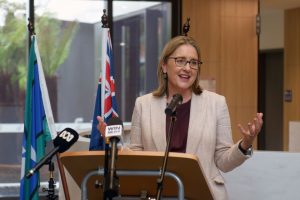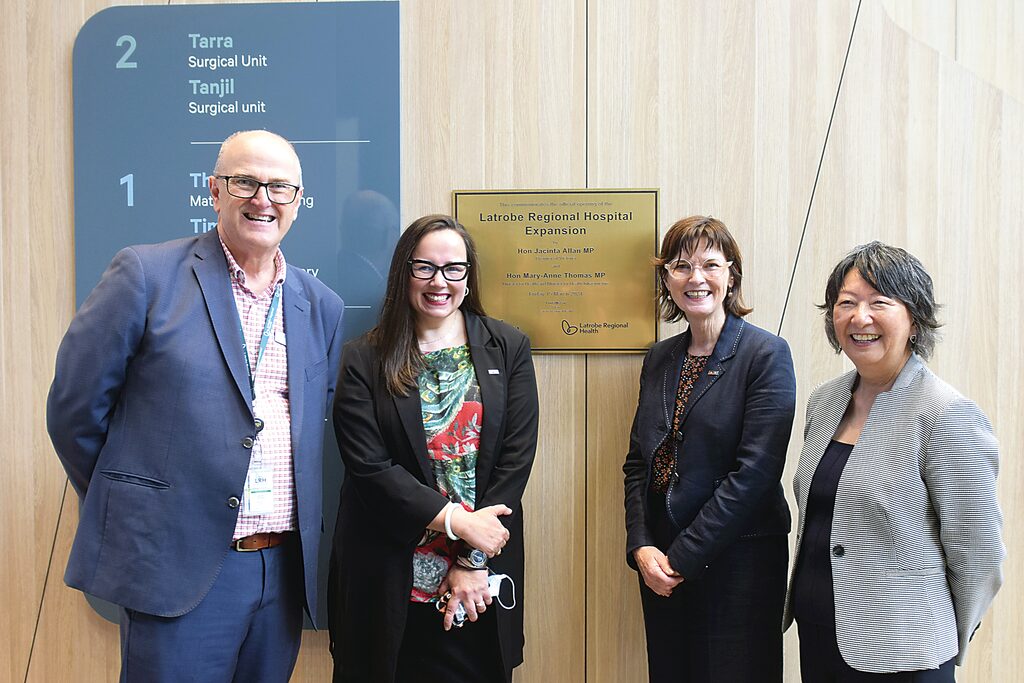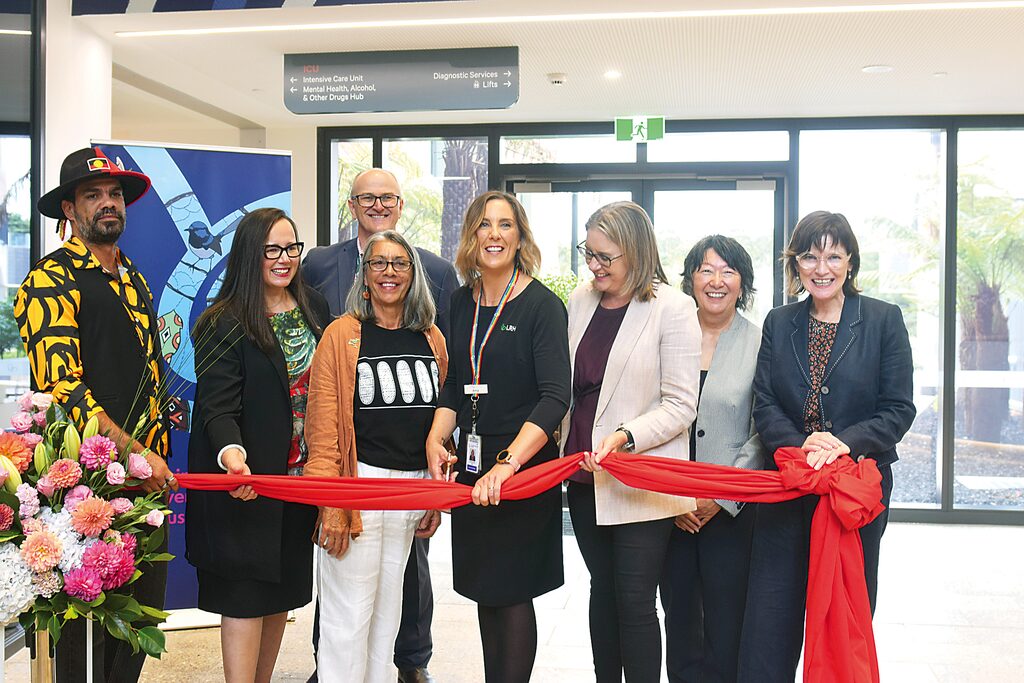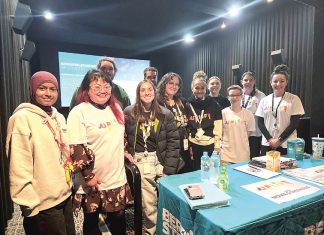By ZAIDA GLIBANOVIC
THE Premier of Victoria, Jacinta Allan, and the Minister of Health, Mary-Anne Thomas, visited the Latrobe Regional Hospital (LRH) last Friday (March 15), to officially open the ‘world-class’ $223.5 million expansion.
The Premier’s Office and ministers toured the hospital’s new wing, chatting with families in the maternity ward.
The state government said the hospital would cater to Gippsland’s growing population. The new maternity ward features two birthing suites, six beds, six special care nursery cots, a parent’s retreat, and a kid’s play area both indoors and outdoors.
“With this expansion, we are able to continue that work that we’ve been doing for years and years and looking at how we can continue to expand the care for regional communities closer to where people live,” said the Premier.
Access to leading specialised care has been an issue for people living in regional and rural communities, but with LRH’s upgrades, the state government is confident locals will have access to better care, closer to home.
“We know that if you’re coming to a hospital in our regional areas, extra travel that you may have to undertake to get to the hospital that provides these services can add to that stress,” the Premier said.
“We’re making sure people across the Latrobe Valley get the world-class healthcare they need without travelling to the city – meaning new mums can give birth closer to home and, importantly, closer to their support network.”

The LRH board chair, Linda McCoy, said the expansion’s official opening marked the end of the project but the start of a better healthcare system.
“It is vastly different to any hospital that you would’ve seen and that’s because we do understand a person’s care and their recovery is greatly enhanced by their surroundings and the experience of the service and staff,” she said.
Ms McCoy said the hospital would now have a new intensive care unit, specialised facilities, and new operating theatres to complete an additional 6200 elective surgeries annually.
The upgrades have also given the hospital a large sterilising department, a mental health stay-in unit and a new base for its Aboriginal health unit, prominently featuring artwork by a local artist, Alfred Carter.
“Aside from the bricks and mortar and services, this project also provided work for the people in Latrobe Valley,” Ms McCoy said.
The hospital concluded that, on average, a third of the people contracted to build the upgrades were locals, with seven per cent of the workforce apprentices.
Although the workers who built the hospital were locals, LRH’s chief executive officer, Don McRae, said most of the 130 to 150 staff needed to operate the new facilities would be foreign workers.
“We have had tremendous success out internationally; we’ve been able to recruit 60 nurses from the UK, and we’re just sifting through at the moment 172 applications from New Zealand; we’re really confident that over the next 12 months, we’ll be able to fill those places,” he said.
Victoria’s health system is under pressure; Victoria University research indicates an increased demand for nurses yet little supply, and healthcare professionals are exiting the industry amid reasons such as aging populations and burnout.
LRH has tried to combat this by taking recruitment to the global stage and has garnered much interest internationally.
The hospital aims to be fully operational within the next 12 months.
The Minister for Housing and Member for Eastern Victoria, Harriet Shing, was questioned about how the state government planned to help house the foreign workforce given that regional Victoria’s vacancy rates have fallen below 1 per cent.
Ms Shing acknowledged the housing crisis regarding affordability and availability issues, but cited the state’s Big Build as a program that would help ease pressures.
“The housing statement that was announced last year is about bringing 800,000 additional homes to Victoria over the next 10 years,” she said.
The state government also has a regional worker accommodation fund of $150 million.
The Victorian government’s housing statement has yet to move out of the planning stage, as Ms Shing said planning was integral to the construction of these houses.
“We want to make sure that we provide opportunities for people to live in communities that are well serviced …. And that’s why the planning the minister has begun a process of consultation,” she said.
Mr McRae said the hospital would work with local agencies and Federation University Gippsland to help house the foreign workforce.
The Minister for Health took the opportunity to encourage young people in the Valley to pursue a career in healthcare with this new facility in their backyard eager to facilitate their training alongside Federation University.
The Premier staunchly opposed comments from Member for Gippsland South, Danny O’Brien, who recently claimed that Gippsland’s emergency departments were “on life support”, citing local hospitals’ failure to meet their emergency department access targets.
Premier Allan vehemently criticised former opposition governments and their mishandling of the healthcare system.
“What doesn’t help that is when hospitals are privatised, closed and had their funding cut – like what occurred when the Liberal Party had the opportunity to be responsible for hospital and health service delivery in communities like this one – the Minister (Ms Thomas) made the observation that this is a hospital that a former Liberal government privatised and a former Labor government had to buy back,” she said.
Emergency department access still remains a growing concern at LRH. According to the Australian Institute of Health and Welfare, in 2022/23, the proportion of patients ‘seen on time’ at LRH’s emergency department was 65 per cent, down from 67 per cent in 2021/22 and from 71 per cent in 2018/19.
Ms Thomas told the Express that the Victorian government was working to relieve the pressures on the state’s healthcare system.
“Around the state, we’ve seen unprecedented demand on our emergency departments, and this falls squarely at the feet of the former Liberal National government, who failed to invest in primary care,” she said.
“We know it has never been harder to see a bulk-billing GP, and that’s why our government stepped in and established 29 Priority Primary Care Centres.”
The state government established Priority Primary Care Centres (PPCCs) to relieve the pressure on busy emergency departments by providing GP-led care to people who need urgent care but not an emergency response.

Functional: The Premier toured LRH’s new maternity unit.

Team: LRH Chief Executive, Don McRae, MP Harriet Shing, Health Minister Mary-Anne Thomas and LRH Board Chief Linda McCoy.

World-class: Minister for Health, Mary-Anne Thomas.











